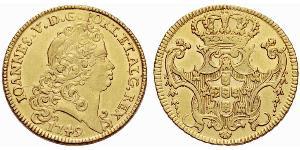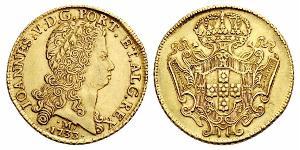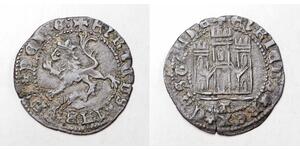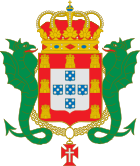| João V | |||||
|---|---|---|---|---|---|

D. João V of Portugal;
Pompeo Batoni.
|
|||||
| King of Portugal and the Algarves (more...) | |||||
| Reign | 9 December 1706 – 31 July 1750 | ||||
| Acclamation | 1 January 1707; Lisbon | ||||
| Predecessor | Pedro II | ||||
| Successor | José I | ||||
| Spouse | Maria Anna of Austria | ||||
| Issue among others... |
Barbara, Queen of Spain Pedro, Prince of Brazil Joseph I of Portugal Peter III of Portugal |
||||
|
|||||
| House | House of Braganza | ||||
| Father | Pedro II of Portugal | ||||
| Mother | Maria Sofia of Neuburg | ||||
| Born | 22 October 1689 Ribeira Palace, Lisbon |
||||
| Died | 31 July 1750 (aged 60) Ribeira Palace, Lisbon |
||||
| Burial | Royal Pantheon of the House of Braganza | ||||
| Religion | Roman Catholicism | ||||
| Signature |  |
||||
D. João V (English: John V; 22 October 1689 – 31 July 1750), known as the Magnificent (Portuguese: o Magnânimo) and the Portuguese Sun King (Portuguese: o Rei-Sol Português), was a Braganza monarch who ruled as King of Portugal and the Algarves during the first half of the 18th-century. João V raised the prestige of Portugal, which had been in a long decline amongst European courts, [1] to a new and glorious level of prosperity and wealth.
João V's reign saw an enormous influx of gold to the coffers of the King's Treasury, mainly based on the royal fifth from the Portuguese colonies of Brazil and Maranhão. With the combined wealth of the government and the royal household, João V was able to entertain an incredibly lavish court, one of the richest in Europe, which coincided with the enrichment of the Portuguese nobility. João V's wealth also allowed him to firmly rule the country as an absolute monarch, devoting a large portion of policy to keep the growing nobility in check. The Portuguese Sun King tied his enormous appetite for luxury and his lust for political control together by constructing the Royal Palace of Mafra, a foreboding palatial complex that dictated João's wealth and power to his empire and to the church.
João V was a very pious man who devoted large parts of his day to prayer and religious study. He rewarded his long awaited recognition as a lawful monarch by Pope Benedict XIV with a fervent devotion to the Catholic Church and some very large donations to the Vatican. The Pope granted João V the styling of 'Most Faithful Majesty', which greatly pleased him. Though he looked to the Church for acceptance and praise, João V affirmed that his policies superseded those of the Church, leading to occasional conflict with the Papacy.
Contents
Early life[edit]

João was born at 09:30 on 22 October 1689 at Ribeira Palace,[2] in Lisbon, to King Pedro II and Queen Maria Sofia of Neuburg. He was baptized on November 19, at the Royal Palace Chapel, and given the name João Francisco António José Bento Bernardo.[3] João was not his father's first son, João had had an older brother, of the same name, that had died a year before João's birth. Thus, with João's birth, the court was overjoyed for the new male heir to the kingdom.
Upon João's birth, he was not given the traditional titles of the heir apparent to the Portuguese throne, Prince of Brazil and Duke of Braganza, but merely the default title of Infante of Portugal. This was a to be a sign of respect for his older brother's death, having happened only months before.
Education[edit]
João had a rich upbringing, being surrounded by some of the greatest minds of all Europe at the time. It was agreed upon by the court that João's infancy was to be strictly run by women only, a custom of the Portuguese court, and Portuguese nobility as a whole.[4] João's, and later all of Pedro II's son's, governess was D. Maria de Lencastre, the Marquise of Unhão, who was given that position more for her beauty and status than for her efficiency as a child care giver.[4]
João's father's policies had made the Portuguese Court rich, the national economy stable, and the imperial military strong. This allowed a for a rich and interesting childhood of João. Growing up, João was under the tutelage, and heavy influence, of the Jesuit Fathers Francisco da Cruz, João Seco, and Luís Gonzaga. [5] Father Luís Gonzaga was chief for the education of all of King Pedro II's children, teaching them military education, politics, astronomy, nautical stuidies, mathematics, and history. [6] As the prince grew up, he was mentored in political affairs by Luís da Cunha, a prime Portuguese diplomat.[6]
Maturity[edit]

When João reached the age of seven, his father determined his eldest sons were sufficiently educated in basic subjects and decided to take control of them directly, though his interest in mentoring them quickly faded.[7] This was formalized when he and his brother, Francisco, Duke of Beja, were admitted into the Order of Christ on 7 April 1696. [6] Later that year, the King finally decided to confer João the titles of the heir apparent, namely Prince of Brazil and Duke of Braganza. On 1 December 1696, on the anniversary of the Portuguese Restoration War, a grand ceremony was held and João was invested with his titles. [6] The ceremony involved the placing of a large ermine and red velvet mantle on João, alongside various jewels and regalia.[6]
Just over a month before João's 10th birthday in 1699, his mother, Queen Maria Sofia of Neuburg, died at the age of 33.[8] This caused João to retreat from court and become depressed for many months.[8] Catherine of Braganza, João's aunt and the former Queen consort of England, Scotland, and Ireland, returned to Portugal, to help João revitalize himself and to take over his education.[8] She resided in the palace she had built, Bemposta Palace, and remained João's main tutor and female role model until her death in 1705.[8]
In April 1700, João fell incredibly ill and was on his assumed death bed.[6] Fearing for his death, João asked for his last rites and confessed his sins.[6] João eventually (and surprisingly) recovered fully and returned to his normal activities,[6] with his recovery being dubbed a miracle by the court.[6]
The death of João's sister, Teresa Maria, in February 1704, greatly saddened João and cause him to seclude from court for some months and estrange himself with his father, who favoured João's younger brother, Manuel, Count of Ourém.[7] During this time, much gossip was spread and worries arrised for whether João would ever recuperate. In May of that year, João eventually returned to court and reconcile with the King, saying that his saudades for his sister will not get in the way of him performing his duty for the King.[7]
Succession[edit]
In early December 1706, Pedro II had moved himself to the Royal Quinta at Alcântara, as he was growing ill and needed space from the court.[9] On the fifth of that month, the King caught a high fever and the court doctors met to fully examine him.[9] They determined his health was greatly deteriorating.[9] The next day Pedro II called all his children to his bedside and told them of his coming demise. He appointed João as Prince Regent of the Kingdom and asked that all his children follow João's wishes.[10] Though he appointed João the Prince Regent, Pedro II still favoured his youngest son, Infante Manuel, Count of Ourém, and the king gave Manuel a special gift which no other child received.[9]
Acclamation[edit]
On 9 December 1706, at 13:30, King Pedro II of Portugal passed away in his sleep.[10] Following Pedro II's death, Ribeira Palace was redecorated to express the mourning of the king. On the palace's façade towards the Terreiro do Paço, large black banners were hung from the windows for this purpose.[11] A month after Pedro II's death, it was declared appropriate for the João to finally be acclaimed King. Preparations for João's acclamation had already been started and once allowed, the royal palace was, once again, redecorated to celebrate João's acclamation, replacing the black banners with red ones and fruit wreaths being hung throughout all of the palace.[11]
On the day of João's acclamation, 1 January 1707, his new throne was placed on the balcony of the Ribeira Palace's Torre do Rei (Tower of the King).[11] High above Terreiro do Paço hung specially made tapestries illustrating the allegories of Justice and Prudence, to remind the public that these were the traits their king would have.[11] Once João sat down on his throne, wreaths made of gold were laid around the throne and balcony.[11] Wearing his Cross of the Order of Christ, and with the Portuguese Crown Jewels beside him, and not on him, as is Portuguese royal custom, João was acclamed His Majesty, by the Grace of God, King of Portugal and the Algarves, before and beyond the sea in Africa, Lord of Guinea and of Conquest, Navigation, and Commerce of Ethiopia, Arabia, Persia, and India, our Lord, João, the fifth of that name in the table of the Kings of Portugal.
João was now king of an empire that stretched four continents. He was also the head of state of a kingdom that was at war with Spain and France.[11] His first regnal act was to renew Portugal's membership in the League of Augsburg and continue in the war alongside the United Kingdom and the Habsburgs.[11] Portugal quickly supplied more troops to aid her allies in the war. This new level of Portuguese involvement allowed João's general, António Luís de Sousa, Marquis of Minas, to capture Madrid on 28 June 1706. While Portugal put vast resources into the war, contrary to João's predessors, who avoided conflicts in Europe, activity in the war soon lost the interest of the king, having more pressing, and regal, affairs to attend to.
Marriage[edit]
During his life, Pedro II had worked a long time on securing João a marriage to an Austrian archduchess, which guaranteed Portugal's alliance with the Habsburgs.[12] João continued these negotiations and finally succeeded a deal. On 27 June 1707, Fernão Teles da Silva, Count of Vilar Maior, signed a marriage contract with Joseph I, Holy Roman Emperor, which officialized the marriage between João and Emperor Joseph's sister, Archduchess Maria Anna of Austria.[12] The contract also set the Archduchess's dowry at 100,000 crowns, a vast sum for the day.[12]
The armada that Portugal sent to escort Maria Anna, from the Lower Countries to Lisbon, arrived in the Tagus river estuary on 26 October 1708.[12] The flagship, in which Maria Anna travelled, berthed at the docks of Ribeira Palace's private garden, where João, and an a party of the kingdom's richest and most powerful nobles, met the new queen for the first time.[12] The marriage celebrations, that lasted until December 27,[13] were so sumptuous, and costly, that the Count of Povolide said that the King, "celebrated with all the gradeur that he could imagine".[12]
By late 1710, João and Maria Anna had not produced an heir to the throne. It had been two years that the couple had been married and the court was starting to question the future of the House of Braganza. In early 1711, João met with Franciscan Cardenal Nuno da Cunha e Ataíde, High Inquisitor of the Portuguese Inquisition, who told the King that if João promised God to build a Franciscan convent in Mafra, God would deliver to João a long desired heir, and so João promised that if Maria Anna became pregnant before the end of 1711, he would build a Franciscan convent in Mafra.[14] João's wish would come true later that year, when Maria Anna fulfilled her duty as Queen and wife and gave birth to Infanta Maria Barbara of Braganza on 4 December 1711.[15]
João and Maria Anna had a successful marriage, but lived largely separate lives. Maria Anna devoted herself to preserving structure at court and her religious interests, while João concerned himself with whatever pleased him at the moment.[16] João kept many mistresses throughout his royal career, including D. Filipa de Noronha, Paula de Odivelas, Luísa Inês Antónia Machado Monteiro, Madalena Máxima de Miranda, Inácia Rosa de Távora, and Luísa Clara de Portugal.
Offspring[edit]
Maria Barbara's birth was followed by the birth of Prince Pedro, Prince of Brazil, on 19 October 1712, which temporarily gave João a male heir. Prince Pedro's death, on 29 October 1714, greatly saddened João, but he took solace in the fact that his son, Infante José Francisco of Braganza, had been born on June 6 earlier that same year. Following Infante José's birth, João and Maria Anna would have three more children, Infante Carlos João of Braganza, on 2 May 1716, Infante Pedro Clemente of Braganza, on 5 July 1717, and Infante Alexandre Francisco of Braganza, on 24 September 1723.[15] Of the last three infantes, only two would survive to adulthood, Infante Carlos João and Infante Pedro Clemente, and of whom only one would continue the Braganza line, Infante Pedro Clemente.
João's children received rigorous training, while growing up. It was João's plan to have an intelligent son for King, a strategically married daughter, and well versed statesmen sons; João would only achieve part of his plan. From her birth, Infanta Maria Barbara's marriage had been closely planned and monitored by João. When Mariana Victoria of Spain's engagement to Louis XV of France was nullified, João proposed Infanta Maria Barbara as a possible bride for Louis XV, but in the end she was turned down.[17] João still managed to gain something from the dissolution of Louis XV and Mariana Victoria's engagement, a wife for his son, Prince José, and through that a husband for Infanta Maria Barbara, Mariana Victoria's older brother, Prince Fernando, Prince of Asturias. Negotiations between Portugal and Spain opened in 1725, and four years later João's eldest children would have matches.[18] The princesses Maria Barbara and Mariana Victoria were exchanged at a ceremony held on the Caia River, on 19 January 1729.[18] Prince José married Mariana Victoria on 19 January 1729, in Elvas, and Infanta Maria Barbara married Prince Fernando on 20 January 1729, in Badajoz.[19]
For João's three other sons, none would marry in João's lifetime. Infante Alexandre Francisco died at the age of five, and Infante Carlos João died at the age of twenty without any marriage proposals nor children.[20] Only Infante Pedro Clemente would live long enough to marry, but João would not live long enough to see it. Infante Pedro Clemente married the daughter of King José I, his niece, Princess Maria Francisca, Princess of Brazil, on 6 June 1760.[21] When Princess Maria became Queen of Portugal, as Queen Maria I, Prince Pedro became King Pedro III, following Portuguese royal law that if the consort of a queen regnant produced children with the queen regnant, he would become King of Portugal jure uxoris.[21]
From João's various extramarital affairs, João fathered four children, António of Braganza, by Luísa Inês Antónia Machado Monteiro, Gaspar of Braganza, Archbishop of Braga, by Madalena Máxima de Miranda, José of Braganza, High Inquisitor of Portugal, by Paula de Odivelas, and Maria Rita of Braganza, by Luísa Clara de Portugal. Out of his four illegitimate children, the three males were all recognized as João's sons and where collectively known as the Children of Palhavã, after the Palace of Palhavã, belonging to the Marquis of Louriçal, where they lived at João's expense. Maria Rita was never officially recognized as his daughter, but he informally arranged for her life at the Convent of Santos and managed her expenses.[22] The husband of Maria Rita's mother, Jorge de Meneses, attempted to stop João V's actions for Maria Rita, but the King had him exiled to Spain and then England.[23]
Reign[edit]
The series of unsuccessful campaigns that ensued, ultimately terminated in a favourable peace with France in 1713 and with Spain in 1715.
His long reign was characterized by a strengthening of the king's power due to the incomes the crown earned by exploring the newly found gold and diamond mines in the Portuguese colony of Brazil. A fifth of each ton extracted from these mines was crown property, the rest being divided among claim owners, contractors and public administrators. This sudden wealth enabled the king to rule without summoning the Portuguese Cortes, thus becoming an absolute monarch. Due to his centralist ruling, he had to endure the political opposition of several noble families and influential clergymen. In what most probably was an effort to tame the upper nobility, John V built his own Versailles, the grand Royal Palace of Mafra and the Palace of Necessidades and its park, in Lisbon.[24]
John V was the greatest patron of the arts in the Europe of his time. The Portuguese Empire was then extremely rich – Portugal collected more gold from the newly found Brazilian mines over a few decades than Spain took from the remainder of Central and South America over 400 years; there were also the very productive diamond and precious gemstone mines that kept the royal coffers full.[citation needed] With this endless supply of money, he bought some of the greatest art collections available at the time – at a point, in one single occasion, over 80 paintings by great Italian masters were taken into the royal palace in Lisbon. The music library, already the greatest in the world, was enlarged, as was the royal library and other libraries in the country. The King insisted that his ambassadors keep him informed about the state of the arts in foreign countries and would buy only the best from the most reputable artists of the time. Unfortunately, most of the great collections amassed by John V and the Portuguese aristocracy, along with the vast majority of the city of Lisbon, were suddenly destroyed by the great earthquake of 1755 followed by a tsunami and fire.
John V used much of the crown's treasure to develop Portugal's economy (creating new manufactures all over the country), to patronise the arts and intellectuals (royal academies were founded), and to advance his country's prestige among its European neighbors after the Crisis of Succession (1580) and short-lived union with Spain (1580-1640). His foreign policy followed two simple and unaltered rules: political neutrality in European conflicts and constant negotiations with the Vatican in order to be recognised as a lawful monarch. To this end, he spent heavily on bribes to church officials and embassies to the Pope.
His negotiations with the Vatican gained the recognition of Portugal as a lawful sovereign country by Pope Benedict XIV in 1748 and the title "Most Faithful Majesty" bestowed upon him and his successors by a bull.
Six years before receiving this title, John suffered a stroke, which left him partially paralysed and unable to intervene in political affairs. His last years were dedicated to religious activities. His early economic measures, which were unpopular among the upper nobility, became ineffective, and public affairs were so dependent on John's rule that they became almost inoperative. John V died on 31 July 1750 in Lisbon, and was succeeded by his son Prince Joseph.
Titles, styles, and honours[edit]
| Royal styles of João V of Portugal |
|
|---|---|
 |
|
| Reference style | His Most Faithful Majesty |
| Spoken style | Your Most Faithful Majesty |
| Alternative style | Sire |
Titles and styles[edit]
- 22 October 1689 – 1 December 1696 His Highness the Most Serene Infante João of Portugal[6]
- 1 December 1696 – 9 December 1706 His Royal Highness the Prince of Brazil, Duke of Braganza, etc.[6]
- 9 December 1706 – 31 July 1750 His Most Faithful Majesty the King of Portugal and the Algarves.[11]
The official styling of João as King of Portugal:
By the Grace of God, João V, King of Portugal and the Algarves before and beyond the sea in Africa, Lord of Guinea and of Conquest, Navigation, and Commerce of Ethiopia, Arabia, Persia, and India, etc.
Honours[edit]
As monarch of Portugal, João was Grand Master of the following Portuguese Orders:
- Order of Christ
- Order of Saint Benedict of Aviz
- Order of Saint James of the Sword
- Order of the Tower and Sword
Genealogy[edit]
Ancestry[edit]
The ancestry of King João V:
| Ancestors of John V of Portugal | ||||||||||||||||||||||||||||||||||||||||||||||||||||||||||||||||||||||||||||||||||||||||||||||||||||||||||||||||||||||||||||||||||||||||||||||||||||||||||||||||||||||||||||||||||||||||||||||||||||||||||||||||||||||||||||||||||||||||||||||||||||||||||||||||||||||||||||||||||||||||||||||||||||||||||||||||||||||||||||||||||||||||||||||||||||||||||||||||||||||||||||||||||||||||||||||||||||||||||||||||||||||||||||||||||||||||||||||||||||||||||||||||||||||||||||||||||||||||||||||||||||||||||||||||||||||||||||||||||||||||||||||||||||||||||||||||||
|---|---|---|---|---|---|---|---|---|---|---|---|---|---|---|---|---|---|---|---|---|---|---|---|---|---|---|---|---|---|---|---|---|---|---|---|---|---|---|---|---|---|---|---|---|---|---|---|---|---|---|---|---|---|---|---|---|---|---|---|---|---|---|---|---|---|---|---|---|---|---|---|---|---|---|---|---|---|---|---|---|---|---|---|---|---|---|---|---|---|---|---|---|---|---|---|---|---|---|---|---|---|---|---|---|---|---|---|---|---|---|---|---|---|---|---|---|---|---|---|---|---|---|---|---|---|---|---|---|---|---|---|---|---|---|---|---|---|---|---|---|---|---|---|---|---|---|---|---|---|---|---|---|---|---|---|---|---|---|---|---|---|---|---|---|---|---|---|---|---|---|---|---|---|---|---|---|---|---|---|---|---|---|---|---|---|---|---|---|---|---|---|---|---|---|---|---|---|---|---|---|---|---|---|---|---|---|---|---|---|---|---|---|---|---|---|---|---|---|---|---|---|---|---|---|---|---|---|---|---|---|---|---|---|---|---|---|---|---|---|---|---|---|---|---|---|---|---|---|---|---|---|---|---|---|---|---|---|---|---|---|---|---|---|---|---|---|---|---|---|---|---|---|---|---|---|---|---|---|---|---|---|---|---|---|---|---|---|---|---|---|---|---|---|---|---|---|---|---|---|---|---|---|---|---|---|---|---|---|---|---|---|---|---|---|---|---|---|---|---|---|---|---|---|---|---|---|---|---|---|---|---|---|---|---|---|---|---|---|---|---|---|---|---|---|---|---|---|---|---|---|---|---|---|---|---|---|---|---|---|---|---|---|---|---|---|---|---|---|---|---|---|---|---|---|---|---|---|---|---|---|---|---|---|---|---|---|---|---|---|---|---|---|---|---|---|---|---|---|---|---|---|---|---|---|---|---|---|---|---|---|---|---|---|---|---|---|---|---|---|---|---|---|---|---|---|---|---|---|---|---|---|---|---|---|---|---|---|---|---|---|---|---|---|---|---|---|---|---|---|---|---|---|---|---|---|---|---|---|---|---|---|---|---|---|---|---|---|---|---|---|---|---|---|---|---|---|---|---|---|---|---|---|---|---|---|---|---|---|---|---|---|---|---|---|---|---|---|---|---|---|---|---|---|---|---|---|---|---|---|---|---|---|---|---|---|---|---|---|---|---|---|---|---|---|---|---|---|---|---|---|---|---|---|---|---|---|---|---|---|---|---|---|---|---|---|---|
|
||||||||||||||||||||||||||||||||||||||||||||||||||||||||||||||||||||||||||||||||||||||||||||||||||||||||||||||||||||||||||||||||||||||||||||||||||||||||||||||||||||||||||||||||||||||||||||||||||||||||||||||||||||||||||||||||||||||||||||||||||||||||||||||||||||||||||||||||||||||||||||||||||||||||||||||||||||||||||||||||||||||||||||||||||||||||||||||||||||||||||||||||||||||||||||||||||||||||||||||||||||||||||||||||||||||||||||||||||||||||||||||||||||||||||||||||||||||||||||||||||||||||||||||||||||||||||||||||||||||||||||||||||||||||||||||||||
Issue[edit]
| Name | Portrait | Lifespan | Notes |
|---|---|---|---|
| By Maria Ana of Austria (7 September 1683 – 14 August 1754; married by proxy on 27 June 1708) | |||
| Infanta Maria Barbara of Portugal | 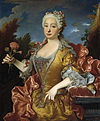 |
4 December 1711 – 27 August 1758 |
Married Fernando VI, King of the Spains. She had no children from this marriage. |
| Pedro, Prince of Brazil | 19 October 1712 – 29 October 1714 |
Prince of Brazil from birth to his death | |
| Joseph I of Portugal | 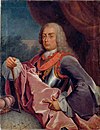 |
6 June 1714 – 24 February 1777 |
King of Portugal from 1750 until 1777. He was married to Mariana Victoria of Spain, daughter of Philip V, King of the Spains. He had four children from this marriage. |
| Infante Carlos of Portugal | 2 May 1716 – 1 April 1736 |
He died at the age of 19, of a fever. | |
| Peter III of Portugal |  |
5 July 1717 – 25 May 1786 |
King of Portugal, jure uxoris, from 1777 until 1786. He was married to Maria I, Queen of Portugal. He had seven children from this marriage. |
| Infante Alexandre of Portugal | 24 September 1723 – 2 August 1728 |
He died at the age of 4, of smallpox. | |
| By Luísa Inês Antónia Machado Monteiro | |||
| António of Braganza | 1 October 1714 – 14 August 1800 |
One of the three Children of Palhavã. João V recognized him and gave him share of his estate. | |
| By Madalena Máxima de Miranda (c.1690 – ) | |||
| Gaspar of Braganza | 8 October 1716 – 18 January 1789 |
Primate-Archbishop of Braga from 1758 until 1789. One of the three Children of Palhavã. João V recognized him and gave him share of his estate. | |
| By Paula de Odivelas (c.1690 – ) | |||
| José of Braganza |  |
8 September 1720 – 31 July 1801 |
High-Inquisitor of the Portuguese Inquisition from 1758 until 1777. One of the three Children of Palhavã. João V recognized him and gave him share of his estate. |
| By Luísa Clara de Portugal (21 August 1702 – 31 August 1779) | |||
| Maria Rita of Braganza | 1731 - 1808 | Nun at the Convent of Santos, in Lisbon. João V did not officially recognize her, but he paid for her expenses. | |
References[edit]
- ^ Carmo Reis, Vol V.
- ^ Caetano de Sousa, Vol VIII, p. 1.
- ^ Caetano de Sousa, Vol VIII, p. 2.
- ^ a b Nizza da Silva, p. 19.
- ^ Veríssimo Serrão, Vol V, p. 234.
- ^ a b c d e f g h i j k Nizza da Silva, p. 21.
- ^ a b c Nizza da Silva, p. 22.
- ^ a b c d Nizza da Silva, p. 20.
- ^ a b c d Nizza da Silva, p. 23.
- ^ a b Nizza da Silva, p. 24.
- ^ a b c d e f g h Nizza da Silva, p. 26.
- ^ a b c d e f Nizza da Silva, p. 28.
- ^ Nizza da Silva, p. 30.
- ^ Instituto dos Museus e da Conservação (22 July 2011). "Palácio Nacional de Mafra". Museus e Palácios. Retrieved 5 January 2013.
- ^ a b Nizza da Silva, p. 42.
- ^ Nizza da Silva, p. 33.
- ^ Nizza da Silva, p. 44.
- ^ a b Nizza da Silva, p. 45.
- ^ Nizza da Silva, p. 47.
- ^ Nizza da Silva, p. 54.
- ^ a b Nizza da Silva, p. 55.
- ^ Pimentel, p. 97.
- ^ Pimentel, p. 98.
- ^ http://www.portugal.gov.pt/pt/os-ministerios/ministerio-dos-negocios-estrangeiros/quero-saber-mais/quero-aprender/mne-palacio-necessidades.aspx
Bibliography[edit]
- Bernardes Branco, Manoel (1886). Portugal na Epocha de D. João V (in Portuguese). Lisbon: Livraria Antonio Maria Ferreira.
- Brasão, Eduardo (1938). Relações Exteriores de Portugal: Reinado de D. João V (in Portuguese) I. Porto: Editora Record.
- Brasão, Eduardo (1938). Relações Exteriores de Portugal: Reinado de D. João V (in Portuguese) II. Porto: Editora Record.
- Brasão, Eduardo (1938). Relações Exteriores de Portugal: Reinado de D. João V (in Portuguese) III. Porto: Editora Record.
- Carmo Reis, A. do (1987). Atlas de História de Portugal (in Portuguese) V. Lisbon: Edições Asa.
- Caetano de Sousa, António. História Genealógica da Casa Real Portuguesa (in Portuguese) VIII. Lisbon: Silviana.
- Fugeiredo, Lucas (2011). Boa Ventura! A Corrida do Ouro no Brasil 1697-1810 (in Portuguese) II. Rio de Janeiro: Editora Record.
- Nizza da Silva, Maria Beatriz (2009). Reis de Portugal: D. João V (in Portuguese). Lisbon: Temas & Debates.
- Pimentel, Alberto (1892). As Amantes de D. João V (in Portuguese). Lisbon: Typografia da Academia Real das Sciencias.
- Rendina, Claudia (2005). I Papi (in Italian) I. Roma: Newton & Compton Editori.
- Veríssimo Serrão, Joaquim (1977). História de Portugal (in Portuguese) V. Lisbon: Editorial Verbo.
External links[edit]
| Wikimedia Commons has media related to John V of Portugal. |
- Joao V 'o Magnanimo' King of Portugal 1706-1750 Genealogics.org
- A Música na época de D. João V Music in the Time of D. João V
- A sociedade portuguesa no tempo de D. João V Portuguese Society in the Time of D. João V
- D. João V: Um Deslumbramento Português D. João V: The Glamourous Portuguese
- D. João V, Rei de Portugal Geneall.net
|
|
John V of Portugal
Cadet branch of the
House of Aviz
Born: October 22 1689 Died: July 31 1750 |
||
| Regnal titles | ||
|---|---|---|
| Preceded by Pedro II |
King of Portugal and the Algarves 9 December 1706 – 31 July 1750 |
Succeeded by José I |
| Portuguese royalty | ||
| Vacant
Title last held by
João |
Prince of Brazil Duke of Braganza 1 December 1696 – 9 December 1706 |
Vacant
Title next held by
Pedro |
|
||||||||||||||||||||||||
|
|
||||||
|
||||||||||||||||
|
||||||||||||||||||||||||||||||||||||||||||||||||||||||||||||||||||||||||||||||||||||||||||||||||||||||||||
|
|||||||||||||||||||||||||||||||||||||||||||||||||||||||||||||||||||||||||||||||||||||||||||||||||||||||||||||||||||||||||||||||||||||||||||||||||||||||||||||||||||||||||||||||||||||||||||||||||||||||||||||||||||||


